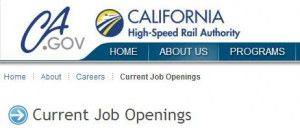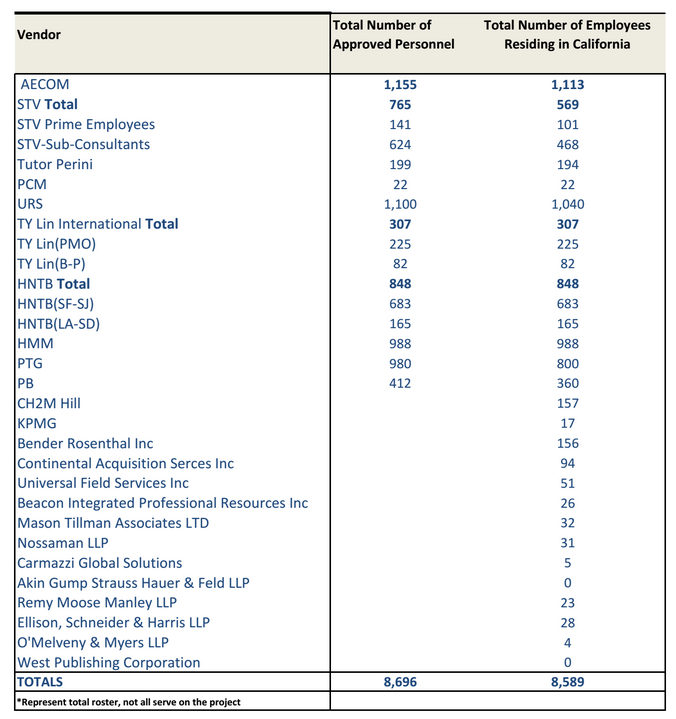How accurate are high-speed rail jobs reports?
by Kathy Hamilton | September 4, 2014 8:49 am
 How many jobs is the California high-speed rail project creating? As California’s unemployment rate remains above the national number[1], it’s a crucial question.
How many jobs is the California high-speed rail project creating? As California’s unemployment rate remains above the national number[1], it’s a crucial question.
The California High-Speed Rail Authority has numbers of jobs created as of April. As reported by McClatchy[2], the CHSRA says “71 companies working on the rail project have offices in the Central Valley; 47 of these are in the Fresno and Clovis area. Statewide, the rail authority says 8,589 California-based employees were working on the project as of April.”
CalWatchdog.com did a public records request to see how these numbers were calculated. The CHSRA’s group stalled for several weeks and finally admitted, “[T]he number 8,589 was wrong and the result of a mathematical error. Three contractors were counted twice, so the Authority’s jobs analysis was really 6,865 as of April 2014.”
Construction has not started, so these “current” job numbers represent primarily engineers, land acquisition people and other consultants.
CalWatchdog.com brought up those numbers with Rita Wespi, co-founder of Californians Advocating Responsible Rail Design[3]. Her organization made public records requests for the monthly progress reports[4] of the project’s regional consultants. These reports show how the project is developing on individual segments’ progress, issues and finances.
Wespi compared the actual, billable hours for fiscal 2012-2013 for the regional consultants and calculated the full-time equivalent jobs. Bottom line: When all the billed hours were added up, she found only 432 full-time equivalent (FTE) jobs compared with the CHSRA’s (revised) 6,865 job count.
How could this be? Wespi provided three reasons:
- The CHSRA’s employee count includes people who may have spent a negligible number of hours on the project. The CHSRA count is not of jobs, or even of job “years.” Instead, it counts anyone who “touched the project,” however briefly.
- The employee count includes people who did not work on the project. From the fine print at the bottom of the table it reads, “Represent total roster, not all served on the project.” Here’s an image of the table from the CHSRA:

- 3. The employee count represents those who worked on (or touched or were authorized to touch) the project years ago. It is unclear how far back the count goes, but at least one contract was from 2006 and several contracts/vendors are no longer active.
HNTB is the most blatant example. It stopped working on the San Francisco-San Jose section about two years ago, yet the table above suggests 683 personnel.
Authority warned about misleading claims
So the CHSRA had these numbers, which certainly showed a different way of counting. That’s not illegal. But without disclosure explaining what those numbers mean, it puts out a false impression of inflated job numbers.
People assume these are full-time, currently employed people working on the project. No one would have guessed the number represented a conglomeration of past workers, part time workers, even those who actually hadn’t worked on the project. All this could have been explained.
Before the CHSRA actually used the numbers, it sought an opinion from its consulting firm, Parsons Brinckerhoff, the primary engineering company directing the project.
Richard Frankhuizen, PB director of operations, advised CHSRA CFO Russell Fong in an email “not to use numbers on a certain spreadsheet because years ago the authority presented the numbers as outlined in a spreadsheet.”
He said it went sideways in the press immediately and he must strongly advise against using the spreadsheet to represent how many folks are serving on the program.
Frankhuizen offered a couple of suggestions for the authority to use:
- Full-time equivalents (FTEs) of 500-600 people; or
- At the present time the program includes between 500 and 1,000 full and part-time personnel.
But the CHSRA did not want to take his advice; it wanted to use headcount numbers for each group. Fong responded on March 18 in an email to Frankhuizen’s suggestions, “We need real bodies not PY’s [partial years] or FTE’s [full-time equivalents].”
It is unclear what Fong actually knew about what the numbers represented. CalWatchdog.com asked him: If the bodies in the headcount had not worked on the project in that quarter? Or had worked on the project a long time ago? Or were people who were qualified to do so, but hadn’t work on the project at all, and were included in the count?
Fong never responded to the inquiries.
Authority spokeswoman explains thinking
CalWatchdog.com also posed several questions to Lisa Marie Alley, the CHSRA’s deputy director of public affairs:
- What were the instructions given by the CHSRA to the contractors?
- If not in the instructions, what was the time period behind the “point in time”?
- What are the new American Recovery and Investment Act (2009 Obama stimulus plan) requirements as to reporting new jobs created?
- After the collection of these jobs data, why weren’t the numbers used in the April 2014 CHSRA Board Meeting?
- What exactly were the reporters told as to the composition of the numbers collected? These numbers were in June; why was Dan Richard using the old number from March?
Alley did respond, but not directly to the questions. By phone, she explained the purpose behind collecting current job numbers was to show how many people touched the project.
In an email, Alley added, “As we discussed, the authority was working with our contractors to determine how many people within their companies have or had worked on the project as the start of data collection for a potential report.”
When presented with quotes from Dan Richard made in the June time frame, Alley said during those interviews the reporters were told these numbers represented all the people who touched the project.
Ultimately, this adds to the credibility gap the CHSRA has with public — on top of other problems CalWatchdog.com has covered[5]: suspect project costs, a shortage of capital funds suspect operating costs and ever-changing start dates for the start of construction.
Kathy Hamilton is the Ralph Nader of high-speed rail, continually uncovering hidden aspects of the project and revealing them to the public. She started writing in order to tell local communities how the project affects them and her reach grew statewide. She has written more than 225 articles on high-speed rail and attended hundreds of state and local meetings. She is a board member of the Community Coalition on High-Speed Rail; has testified at government hearings; has provided public testimony and court declarations on public records act requests; has given public testimony; and has provided transcripts for the validation of court cases.
- remains above the national number: http://www.sacbee.com/2014/08/15/6631247/california-unemployment-steady.html
- reported by McClatchy: http://www.mcclatchydc.com/2014/06/10/229940/house-votes-against-california.html
- Californians Advocating Responsible Rail Design: http://www.calhsr.com/
- progress reports: http://www.calhsr.com/resources/progress-reports/
- CalWatchdog.com has covered: http://calwatchdog.com/?s=chsra+hamilton
Source URL: https://calwatchdog.com/2014/09/04/how-accurate-are-high-speed-rail-jobs-reports/